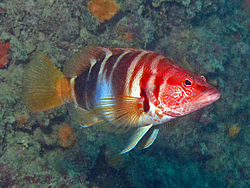| Painted comber | |
|---|---|
 | |
| Painted comber (Serranus scriba) | |
| Scientific classification | |
| Kingdom: | Animalia |
| Phylum: | Chordata |
| Class: | Actinopterygii |
| Order: | Perciformes |
| Family: | Serranidae |
| Genus: | Serranus |
| Species: | S. scriba |
| Binomial name | |
| Serranus scriba | |
| Synonyms [2] | |
| |
The painted comber (Serranus scriba) is a species of marine ray-finned fish, a sea bass from the subfamily Serraninae, classified as part of the family Serranidae which includes the groupers and anthias. It is found in the eastern Atlantic Ocean, the Mediterranean Sea, and the Black Sea. Confusingly, a synonym of this species is Perca marina, but that name (as Sebastes marinus) has incorrectly been used for a separate species, the rose fish.



